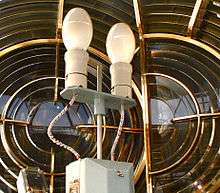Automatic lamp changer

An automatic lamp changer (or lampchanger) is a device used to ensure that a navigational light such as a marine lighthouse or aero beacon stays lit even if a bulb burns out. Numerous types exist. The common design elements are an array of two or more lamps (or bulbs), installed on a mounting which can rotate to various positions. Each position brings a different lamp into the focal point of an optical assembly. Since signal and navigational lights use sophisticated optics to focus the beam, lampchangers are designed to position the new bulb at the focal point with high precision. The device automatically detects when the currently active lamp has ceased to function and moves the next lamp into place.
History
The automatic lampchanger was invented by Charles Wallace and patented in 1928 (patent number unknown).[1] This original model held two headlight lamps from a Model T automobile. The United States Lighthouse Service had these in common use by the 1930s, as they moved to convert all navigational lights to electricity.
Types in current use
CG-2P
The CG-2P,[2] manufactured by Carlisle & Finch.[3] This could be installed in a type DCB-224 aero beacon. It consisted of two bulbs and a mechanism to rotate a fresh bulb into place when the primary bulb has burned out.
CG-4P
There is also a CG-4P type, which contains 4 lamps.[4]
CG-6P

The CG-6P, which contains 6 bulbs in a rotary mechanism.[5][6] The specification for the CG-6P are described in UC Coast Guard Specification G-SEC-195H,[7] which describes the CG-6P as used to rotate a 12VDC, marine signal lamp of up to 40 watts into the focal position of a U. S. Coast Guard aids to navigation beacon. The power to operating the rotating mechanism comes from a wound spring. The device is required to operate over a temperature range of -25F to +140F, 0% to 100% relative humidity, and be resistant to corrosion from constant exposure to salt air. The stepping mechanism is required to have a means of manual activation, which must be designed to be activated by personnel wearing heavy winter gloves.
Cybernetica AS, in Estonia, makes a version of the CG-6P called the E390.[8] This combines the basic CG-6P mechanism with a remote monitoring system which transmits diagnostic information giving the state of all six lamps.
Other types
Pharos Marine manufactures the model APL1297A.[1] It comes in a number of varieties, with either 4 or 6 bulbs, and running on either AC or DC power.[9][10]
References
- 1 2 "APL1297A Lampchanger" (PDF). Pharos Marine Automatic Power. Archived from the original (PDF) on 16 March 2012. Retrieved 16 September 2013.
- ↑ "Seeing The Light - The DCB-224 Aerobeacon". Terrypepper.com. Retrieved 2012-07-06.
- ↑ "Aids To Navigation | The Carlisle & Finch Co". Carlislefinch.com. Retrieved 2012-07-06.
- ↑ "Commandant Notice 16500" (PDF). United States Coast Guard. Retrieved 16 September 2013.
- ↑ "Shining Lights and Bell Rock 200". The Feast Bowl. 2010-10-27. Retrieved 2012-07-06.
- ↑ July, David (2010-08-21). "C-R Control Systems, Inc. Lampchanger CG6P/12V6P in the Crooked River Lighthouse museum. | Flickr - Photo Sharing!". Flickr. Retrieved 2012-07-06.
- ↑ Office of Civil Engineering United States Coast Guard (January 2001). "Specification for 12VDC, Six-place Lampchanger for Maritime Aids to Navigation, Type CG-6P" (PDF). Washington, D.C. Retrieved 16 September 2013.
- ↑ "Lampchanger E390". Ekta.ee. 2011-03-01. Retrieved 2012-07-06.
- ↑ "Lampchanger PA2 Series & Diffuser" (PDF). Pelangi. Archived from the original (PDF) on 5 January 2009. Retrieved 16 September 2013.
- ↑ "United States Patent Number 4518233" (PDF). Retrieved 16 September 2013.
_-_cropped.jpg)